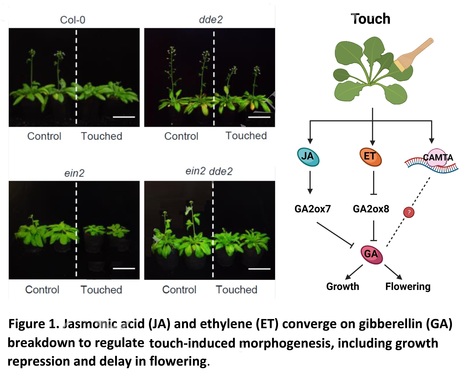Author: Guadalupe L. Fernández-Milmanda
Plant Physiology (2023)
Excerpts: "In this issue of Plant Physiology, Wang et al., 2023 found two molecular pathways that regulate GA metabolism in response to touch, one dependent on JA and one dependent on an unexpected hormonal player, ethylene (ET)."
"Thus, the authors characterized touch-induced morphogenesis in two ET-insensitive lines, ein2 and ein3 eil1. As expected, repetitive touch repressed growth of wild-type plants, leading to more compact (reduced diameter) rosettes that also flowered later than their unstimulated counter parts. The ein2 and ein3 eil1 plants were also responsive to touch but, interestingly, the effect of treatment was stronger than in the wild type, suggesting that ET could be a negative regulator of thigmomorphogenesis (Fig. 1, left)."
"As breakdown of GA is necessary for expression of thigmomorphogenesis (Lange & Lange, 2015), the authors measured levels of GA4, a bioactive GA, in the ET-insensitive lines. They found that touch treatment severely lowered the concentration of GA4 in the ein2 and ein3 eil1 plants, even to a greater extent than in the wild type......Consistent with this model, supplementation of touch-induced ein2 and ein3 eil1 plants with exogenous GA4 rescued the compact growth and delay in flowering time phenotypes."
"In conclusion, Wang and collaborators explored the connection between the pathways of two known regulators of touch-induced morphogenesis, JA and GA. They found that JA activates GA breakdown, leading to decreased growth and delayed flowering. The authors also incorporated ET to the picture. ET acts as negative regulator of thigmomorphogenesis, also through an effect on GA catabolism, but in this case ET represses GA catabolism, likely to prevent exaggerated responses. (Fig. 1). These findings position GA metabolism as a central node in thigmomorphogenesis."



 Your new post is loading...
Your new post is loading...









